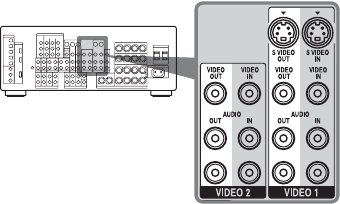
34
GB
Notes on converting video signals
• You can convert only 480i component video
signals into HDMI signals, S video signals,
or video signals. Signals are converted from
480i interlace scanning to 480p progressive
scanning, then the signals are output.
• When video or S video signals from a VCR,
etc., are converted on this receiver and then
output to your TV, depending on the status of
the video signal output, the image on the TV
screen may appear distorted horizontally or
no image may be output.
• HDMI video signals cannot be converted to
component video signals, S video signals,
and video signals.
• The converted video signals are output only
from the MONITOR OUT jacks. They are
not output from VIDEO OUT jacks,
S VIDEO OUT jacks, or the ZONE 2
VIDEO OUT jack.
• S2 information (aspect information for the
images) included in S video signals is
effective only when S video input signals are
output from the S video MONITOR OUT
jack. An aspect ratio of images may not be
displayed correctly when video signals and
component video signals are converted and
are output from the S video MONITOR
OUT jack.
• When you play a VCR with an image
improvement circuit, such as TBC, the
images may be distorted or may not be
output. In this case, set the image
improvement circuit function to off.
Closed Caption display
When the receiver receives video output
signals that are up-converted but the
accompanying closed caption cannot be
displayed, down-convert the video output
signals to the original video signals, and
connect the TV to the MONITOR OUT jack
that outputs the original video signals.
To connect a recording
component
When recording, connect the recording
component to the VIDEO OUT jacks or S
VIDEO OUT jacks of the receiver. Connect
cords for input and output signals to the same
type of jack, as VIDEO OUT jacks and S
VIDEO OUT jacks do not have an up-
conversion function.
Note
Signals output from the MONITOR OUT jacks may
not be recorded properly.


















